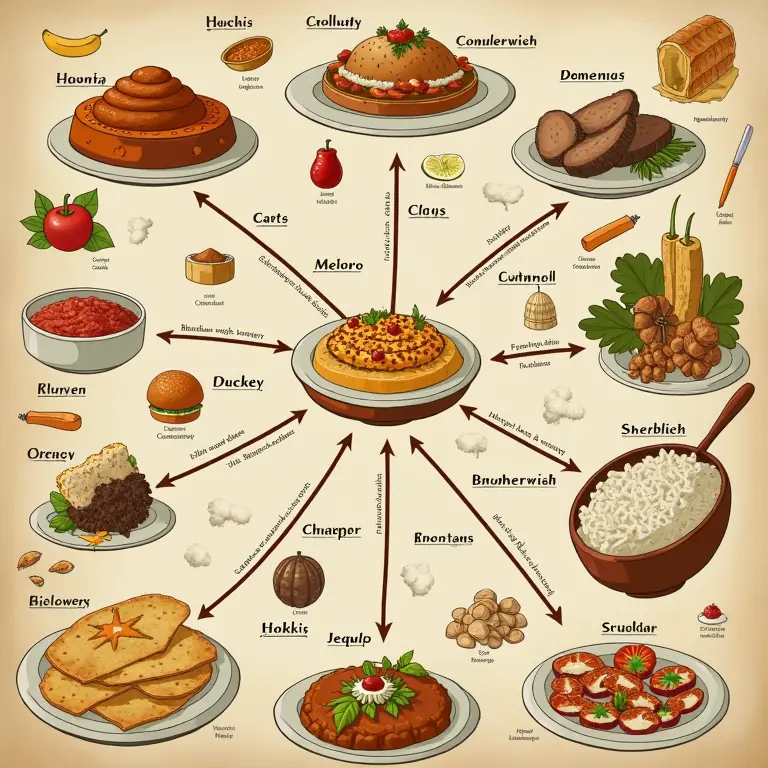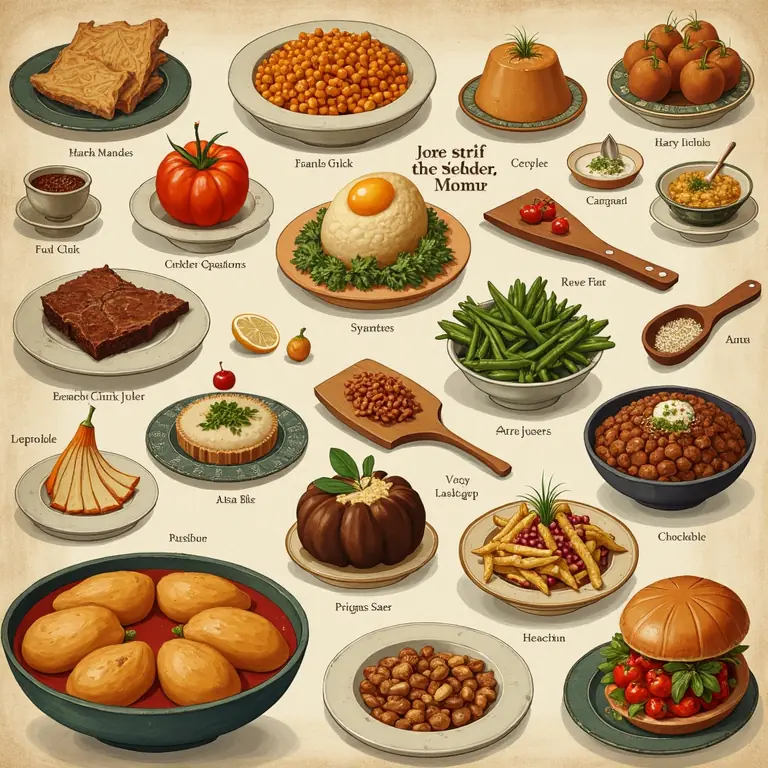Have you ever stopped to consider why we call things what we call them? It’s easy to take the names of our everyday foods for granted – ‘apple,’ ‘cheese,’ ‘chocolate’ – they simply are. But beneath the surface of these familiar terms lies a fascinating world of linguistic history, cultural exchange, and surprisingly consistent patterns in how humans have named what sustains us. This article delves into the etymology of a wide range of food names, revealing their origins, tracing their evolution, and demonstrating the remarkable consistency with which people across time and continents have approached the task of labeling their sustenance. We’ll explore how geographical origins, physical characteristics, historical usage, and even culinary processes have shaped the words we use to describe the foods we eat.
The Roots of Nomenclature: A Universal Approach
Before diving into specific examples, it’s important to understand the broad principles at play. Across languages, the naming of food often centers around a few core themes: origin (where it comes from), appearance (what it looks like), taste & texture (what it’s like to eat), and use (how it’s used). These aren’t mutually exclusive, of course, and a single food name can often draw upon multiple factors. The consistency lies in the fact that humans, regardless of location, tend to observe these same characteristics when encountering a new food source. A bright red fruit, for example, is easily described by its color, while a food originating from a specific region often retains a linguistic tie to that place.
From Orchard to Table: The Story of ‘Apple’
Let’s start with something seemingly simple: the apple. The word ‘apple’ hasn’t always meant the fruit we know today. In Old English, ‘æppel’ was a generic term for any round fruit – plums, peaches, even wild berries could be referred to as apples! It derives from the Proto-Germanic *apald, and ultimately from Proto-Indo-European *h₂epel meaning ‘fruit’. As specific fruits were identified and categorized, the word ‘apple’ gradually narrowed in meaning to refer specifically to the fruit of the Malus domestica tree. This demonstrates a common pattern: a broad, encompassing term becoming more specific over time. This is a beautiful example of how language evolves to reflect increasing granularity in our understanding of the world around us.
Dairy Delights: The Origins of ‘Cheese’
‘Cheese’, too, has a surprisingly deep history. It originates from the Proto-Indo-European root *kwat-, meaning “to ferment, become sour.” This reflects the fundamental process involved in cheesemaking: the controlled spoilage of milk. The word evolved through Proto-Germanic *kasjus to Old English ‘cēse’. The variations we see across languages – ‘fromage’ (French), ‘käse’ (German), ‘queso’ (Spanish) – all stem from this shared ancestral root, highlighting the ancient and widespread practice of dairy fermentation. The very name acknowledges the core transformation that creates this staple food. Interestingly, the process itself is older than the word, suggesting that humans recognized the phenomenon of milk turning into something new long before they had a specific label for it.
A Bitter Beginning: The Tale of ‘Chocolate’
The journey of ‘chocolate’ is particularly rich, reflecting centuries of cultural exchange. It originates from the Nahuatl word ‘xocolātl,’ which referred to a bitter drink made from cacao beans, water, and spices. This drink was highly valued by the Aztecs and Mayans, and played a significant role in their rituals. When the Spanish conquistadors encountered xocolātl, they adapted the word to ‘chocolate,’ but also significantly altered the beverage itself, adding sugar and other ingredients to make it more palatable to European tastes. This demonstrates how food names often travel with the foods themselves, undergoing transformation along the way. The word itself carries the memory of a very different, more bitter original. You can learn more about how consistent patterns emerge in seemingly unrelated fields, such as the intricate craft of Victorian hairwork – a practice equally rooted in memory and symbolism – here.

Grains of Truth: The Etymology of ‘Bread’ and ‘Wheat’
‘Bread’ and ‘wheat’ are fundamental to many cultures, and their etymologies reveal their importance. ‘Bread’ comes from the Old English ‘brēad’, which itself derives from Proto-Germanic *breudam. The root signifies “to bake” or “to swell,” relating to the process of leavening. ‘Wheat’ comes from Old English ‘hwæte’, tracing back to Proto-Indo-European *kwḗitos, meaning ‘grain’. The connection between the grain and the baked product is clear, and the names reflect the essential processes involved in their creation. The consistency here lies in the focus on the making of the food, rather than simply the raw ingredient. Consider how many languages have separate words for the grain and the baked product – it suggests a fundamental distinction in how these are perceived and processed.
Spice Routes and Linguistic Trails: The Story of ‘Pepper’
‘Pepper’ offers a compelling example of how trade and geographical origins shape food names. The word comes from the Old English ‘pipor’, which in turn derives from Latin ‘piper’. However, the Latin ‘piper’ ultimately comes from the Sanskrit ‘pippali’, referring to the long pepper (Piper longum). This illustrates how spices traveled vast distances along trade routes, carrying their names with them. Initially, ‘pepper’ referred to long pepper, but as black pepper (Piper nigrum) became more dominant, the name ‘pepper’ shifted to refer to this more common spice. This demonstrates how language adapts to reflect changes in availability and usage. The journey of pepper also parallels the incredible consistency found in the science of bird migration, where ancient routes and innate senses guide these creatures across vast distances – you can explore this further here.
Sweet Sensations: The Origins of ‘Sugar’
‘Sugar’ has a fascinating etymology, tracing back to Sanskrit ‘śarkarā’, meaning “grit, sandy.” This referred to the granular appearance of raw sugar. The word traveled through Persian ‘shakar’, Arabic ‘sukkar’, and then into Medieval Latin as ‘succarum’. From there, it entered Old French as ‘sucre’ and finally into English as ‘sugar’. This journey reflects the spread of sugarcane cultivation and trade, and the consistent observation of its grainy texture. The name itself is a direct descriptor of its physical properties.
From Latin to Lunch: The Case of ‘Olive’
‘Olive’ has a relatively straightforward etymology, deriving directly from Latin ‘olīva’. This Latin word itself likely originated from an earlier Mediterranean language. The consistency here isn’t in a complex evolution, but in the direct transmission of a name across languages and cultures. The olive tree has been central to Mediterranean life for millennia, and the name has remained remarkably stable. This suggests a deep cultural significance and a lack of need for re-interpretation or adaptation.

Fruits of the Forest: The Story of ‘Berry’
\n
The word ‘berry’ is another example of a term that has broadened and narrowed over time. Originally, it referred to any small, pulpy fruit. However, botanically speaking, many fruits we commonly call berries (like strawberries and raspberries) aren’t true berries! The term comes from Old English ‘berie’, related to Old Norse ‘ber’, meaning “fruit”. Like ‘apple,’ the word’s meaning has become more specific through common usage, even if it doesn’t align perfectly with scientific classification. This highlights the difference between linguistic definitions and scientific ones.
Vegetable Variations: The History of ‘Lettuce’
‘Lettuce’ comes from the Old French ‘laitue’, which itself derives from the Latin ‘lactuca’. This Latin word is connected to ‘lac,’ meaning ‘milk,’ referring to the milky sap produced by the plant when cut. This is a prime example of a food name based on a specific characteristic – in this case, the visible sap. The consistency is in the observational nature of the naming: people noticed the milky substance and incorporated it into the name.
Nutty Narratives: The Etymology of ‘Walnut’
‘Walnut’ is a relatively descriptive name. It comes from Old English ‘wealhhnut’, meaning “foreign nut.” This refers to the fact that walnuts were not native to Britain but were imported from other parts of Europe, particularly France and Italy (historically associated with the Roman Empire, or ‘Walha’ to the Anglo-Saxons). The name emphasizes the origin of the food, a common theme in food nomenclature. It’s a reminder that even seemingly simple foods have complex histories tied to trade and cultural exchange.
Beyond Words: The Role of Culinary Processes
It’s not just the origin or appearance of food that shapes its name; the way it’s prepared also plays a role. Consider ‘sausage,’ which comes from the Latin ‘salsus,’ meaning “salted.” This reflects the traditional method of preserving meat by salting it and encasing it in a casing. Similarly, ‘ham’ comes from Old English ‘hamm’, meaning “hind leg,” specifically the hind leg of a pig that is cured. These names highlight the importance of preservation techniques in shaping food culture and language. The consistency here is the focus on the defining characteristic of the preparation process.
The Persistence of Proto-Indo-European Roots
As we’ve seen, many food names trace back to Proto-Indo-European roots, demonstrating the deep history of agriculture and food culture. This isn’t surprising, as the languages of Europe and much of Asia share a common ancestor. The persistence of these roots suggests that many of the foods we eat today have been cultivated and consumed for millennia. The ability to recognize these patterns speaks to the underlying consistency in human experience and observation. This consistency isn’t limited to language; similar patterns emerge in other areas of human endeavor, like the enduring archetypes found in traditional storytelling – learn more about these universal narratives here.
The Puzzle of Palates: Etymology and Culinary History
The study of food names isn’t just about linguistics; it’s also about culinary history. The names we use for food provide clues about how those foods were discovered, cultivated, traded, and prepared. They tell stories of cultural exchange, innovation, and adaptation. Understanding the etymology of food names can deepen our appreciation for the foods we eat and the cultures that have shaped our culinary traditions. The intricate logic behind antique puzzle boxes, though seemingly distant, shares a similar appeal—a fascination with uncovering hidden histories and the satisfaction of solving a complex puzzle – explore this connection here.
A Final Bite: The Consistency Continues
From the simple ‘apple’ to the exotic ‘chocolate,’ the etymology of food names reveals a remarkable consistency in how humans have named and categorized their sustenance. The focus on origin, appearance, taste, and use is universal, reflecting our shared experience of interacting with the natural world. The next time you sit down to a meal, take a moment to consider the stories behind the names of the foods on your plate. You might be surprised by what you discover. And just as the dynamics of a candle flame reveal a surprisingly consistent science – a history of light, wax, and atmospheric chemistry – explore the fascinating science behind a seemingly simple phenomenon.


 The Curious Chronicle of Lost Recipes: Culinary Secrets Across the Ages
The Curious Chronicle of Lost Recipes: Culinary Secrets Across the Ages  The Curious Lexicon of Lost Trades
The Curious Lexicon of Lost Trades  The Surprisingly Consistent Etymology of Place Names – Uncovering Stories in Street & Town Origins
The Surprisingly Consistent Etymology of Place Names – Uncovering Stories in Street & Town Origins  The Surprisingly Consistent Etymology of Brand Names – How History Shaped What We Buy
The Surprisingly Consistent Etymology of Brand Names – How History Shaped What We Buy  The Surprisingly Consistent Origins of Common Last Names – Tracing Ancestry Through Etymology
The Surprisingly Consistent Origins of Common Last Names – Tracing Ancestry Through Etymology  Echoes of the Past: Uncovering the Origins of Common Idioms
Echoes of the Past: Uncovering the Origins of Common Idioms